How To Identify & Fix Cannabis Root Rot | Combat Root Issues Now



How To Identify & Fix Cannabis Root Rot
When it comes to growing cannabis, root rot can be a serious problem. A plant's root system is essential to its health and growth, and root rot can cause extensive and costly damage to an entire crop.
Learning how to identify and fix this problem can help you reduce the amount of time and money wasted on ruined plants. In this article, you will learn all the signs of root rot, its causes, and how to fight and eliminate it from your plants.
What Is Root Rot?
Root rot is a term that describes a group of fungal diseases that affect the roots of plants. The most common fungi that cause root rot in marijuana plants are Pythium, Fusarium, Rhizoctonia, and Phytophthora. These fungi thrive in wet, warm, and oxygen-poor environments, such as overwatered or poorly drained soil or hydroponic reservoirs.
Root rot can affect any type of plant, but it is more common and severe in hydroponic systems, where the roots are constantly submerged in water. The fungi can enter the roots through wounds or cracks caused by stress, pests, or nutrient deficiencies. Once inside the roots, the fungi multiply rapidly and block the flow of water and nutrients to the rest of the plant.
What Are the Root Rot Symptoms?
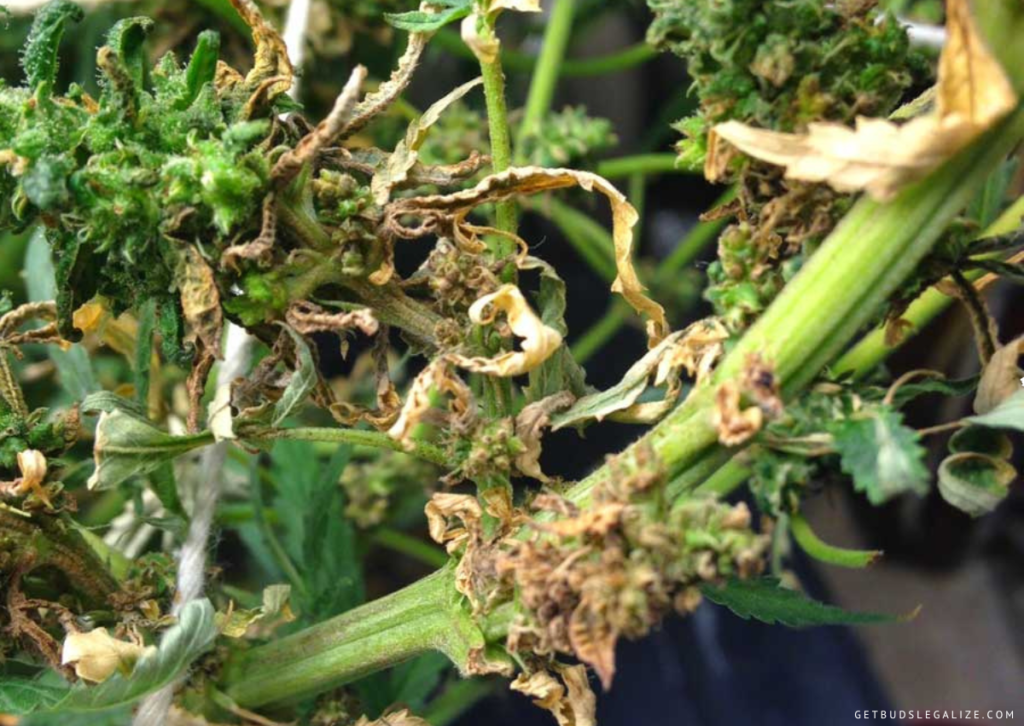
 Root rot cannabis leaves symptoms
Root rot cannabis leaves symptomsCannabis Root rot can be hard to detect in the early stages, as the symptoms may not be visible above the soil or water level. However, as the infection progresses, you may notice some signs in your plants, such as:
- Brown or burnt edges on the leaves.
- Pale or yellow color on the leaves.
- Brown spots or lesions on the leaves.
- Curling or drooping of the leaves.
- Slow or abnormal growth.
- Weak or brittle stems.
- Wilted or fallen plants.
- Brown, mushy roots give off a mildewy or unpleasant odor.
If you suspect your cannabis roots are rotting, you should inspect them as soon as possible.

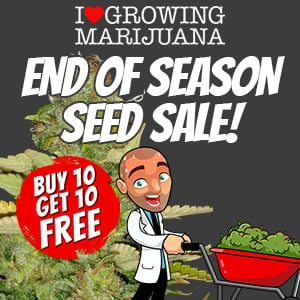
What Causes Cannabis Root Rot?
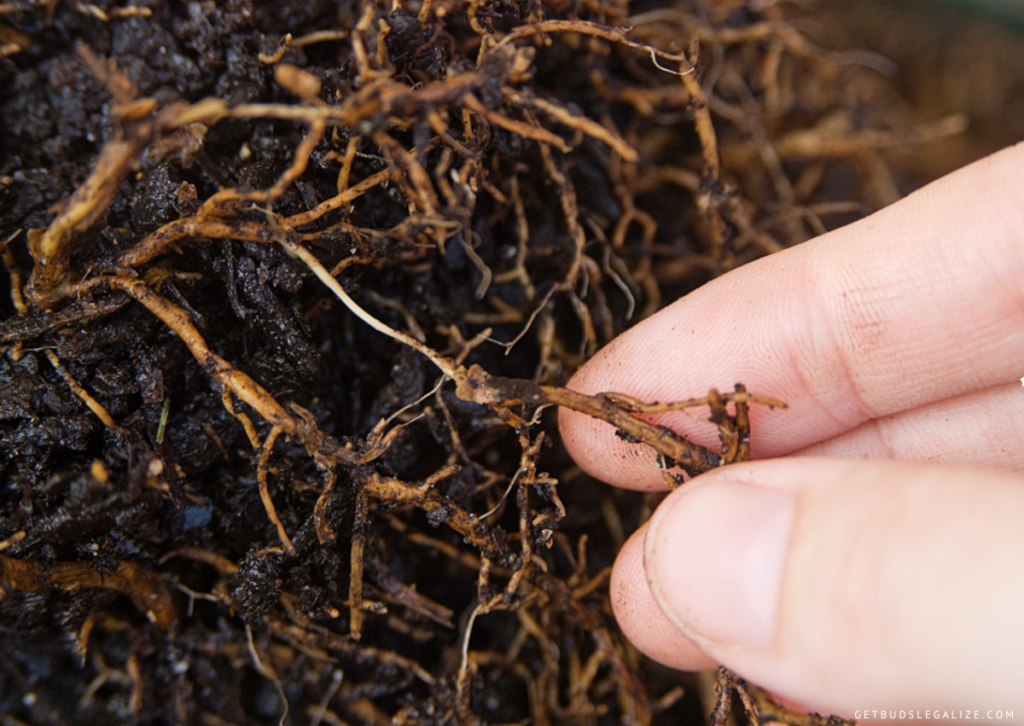
Root rot can be caused by several factors, such as:
1. Improper watering practices:
If you water your plants too much, you can create stress and imbalance in the root zone. Too much water can drown the roots deprive them of oxygen and make them susceptible to pathogens.
2. Contaminated water or growing medium:
If you use water or a growing medium that is not clean or sterilized, you can introduce harmful microorganisms into your root zone. These can include tap water that contains chlorine or chloramine, rainwater that is polluted by chemicals or metals, or soil or cococoir that is not properly flushed or pasteurized.
2. Small container size:
If you use a container that is too small for your plant's size and growth stage, you can limit the root development and cause root binding. This can reduce the oxygen and nutrient uptake of your roots and make them more vulnerable to rot.
4. Light leaks:
If you expose your roots to light, you can stimulate the growth of algae and other unwanted organisms in your root zone. This can compete with your plants for oxygen and nutrients and create a favorable environment for root rot pathogens.
5. Poor drainage or aeration:
If you use a soil or hydroponic system that does not have adequate drainage or aeration, you can create stagnant water and low oxygen levels in your root zone. This can suffocate your roots and allow root rot pathogens to multiply.
6. Temperature or humidity extremes:
If your grow room has temperatures or humidity levels that are too high or too low for your plant's needs, you can create stress and imbalance in your root zone. High temperatures can increase the evaporation and transpiration rates of your plants and dehydrate your roots, while low temperatures can slow down the metabolism and growth of your roots. High humidity can increase the moisture and condensation levels in your root zone and create fungal growth, while low humidity can dry out your roots and make them brittle.
7. Decayed matter:
The accumulation of decaying matter in hydro reservoirs or growing mediums can facilitate the rapid growth of harmful bacteria.

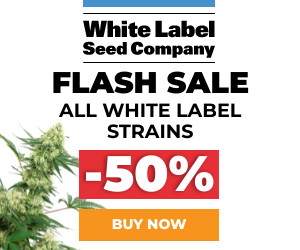
How to Prevent Root rot?
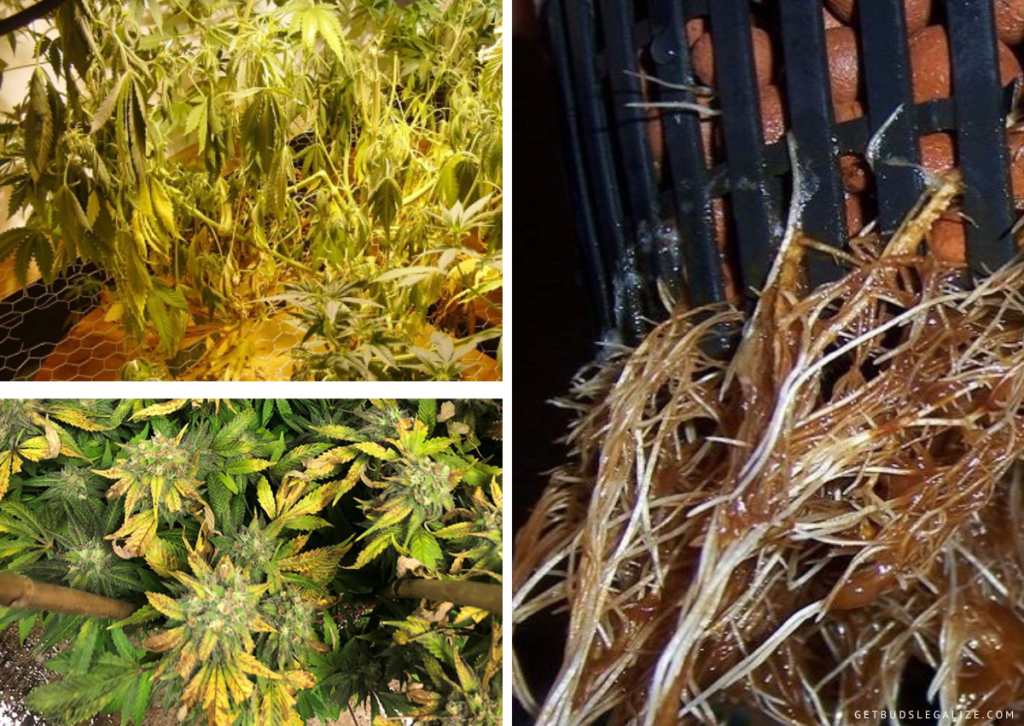
The best way to prevent cannabis root rot is to provide them with optimal growing conditions and avoid stress factors that can weaken their immune system. Here are some tips to prevent it:
1. Water your plants only when they need it: Check the moisture level of your soil or growing medium by using a moisture meter or by lifting the pots and feeling their weight. Avoid overwatering or underwatering your plants.
2. Use clean and sterile water and growing medium for your plants: You can use filtered water or reverse osmosis water and add beneficial bacteria or enzymes to fight harmful fungi in hydroponic systems.
3. Ensure good drainage and aeration in your soil or hydroponic system: To enhance drainage and aeration in your soil, you can add perlite, vermiculite, coco coir, clay pebbles, or other inert materials. Additionally, you can boost oxygen levels in your hydroponic reservoir by using air pumps, air stones, bubblers, or water chillers.
4. Maintain optimal pH levels in your water or growing medium: The ideal pH range for cannabis is between 5.5 and 6.5 for hydroponic systems and between 6.0 and 7.0 for soil systems. Measuring and adjusting pH levels can be done through the use of pH meters, pH test kits, or pH up and down solutions.
5. Maintain optimal temperature and humidity levels in your grow space: The ideal temperature range for cannabis is between 68°F and 77°F (20°C and 25°C) and the ideal humidity range is between 40% and 60%. To maintain these conditions, you can utilize tools such as thermometers, hygrometers, fans, heaters, humidifiers, or dehumidifiers for precise control.
6. Provide adequate nutrients for your plants: You can use organic or synthetic fertilizers designed for cannabis plants. You can also use compost tea, worm castings, bat guano, or other natural amendments to enrich your soil. It's important to follow the manufacturer's instructions and avoid overfeeding or underfeeding your plants.
7. Prevent pests and diseases from attacking your plants: To safeguard your plants from pests and diseases, you have the option of employing organic or synthetic pesticides, fungicides, or insecticides. Alternatively, you can opt for neem oil, diatomaceous earth, sticky traps, or other natural approaches to discourage or eradicate pests and diseases. It is advisable to examine your plants frequently and eliminate any infected or damaged portions.
8. Apply Hydroguard: This is a beneficial microbe product that colonizes the roots and protects them from harmful pathogens. It also helps to increase the oxygen levels in the root zone, which is essential for healthy growth. You can apply it to your soil or hydroponic system according to the instructions on the label. It is safe, natural, and effective.


How to Fix Root Rot in Cannabis Plants

If you have root rot in your plants, you should act quickly and try to save them before it's too late. Here are some steps you can follow:
1. Remove the infected plants from the rest of the plants and place them in a separate area.
2. Cut off any brown, mushy, or rotten roots with sharp and sterile scissors or knife. Leave only healthy white roots intact.
3. Rinse the remaining roots with clean water to remove any dirt or debris.
4. Soak the roots in a solution of hydrogen peroxide (H2O2) and water for 10 to 15 minutes. Use a ratio of 3% H2O2 to 97% water. This will help kill any remaining fungi and oxygenate the roots.
5. Transplant the plants into a new clean and sterile growing medium. You can use the same type of growing medium as before or switch to a different one that has better drainage and aeration.
6. Add beneficial root bacteria or enzymes to your water or growing medium to help restore the microbial balance and prevent future infections.
7. Reduce the amount of nutrients you give to your plants until they recover. Use half the recommended dose of fertilizer for the first few weeks after transplanting.
8. Monitor your plants closely and watch for any signs of improvement or deterioration. If your plants show new growth and vigor, you have successfully fixed root rot. If your plants continue to decline and die, you may have to discard them and start over.
Can Root Rot Spread to Other Plants?

Yes, cannabis root rot can spread to other plants through several ways, such as:
- Using the same water or growing medium for infected and healthy plants.
- Using the same tools or equipment for infected and healthy plants without sterilizing them.
- Having poor air circulation or ventilation in your grow space.
- Having splashing water or runoff from infected to healthy plants.
To prevent it from spreading to other plants, you should isolate the infected plants as soon as possible and treat them accordingly. You should also disinfect your water, growing medium, tools, equipment, and grow space regularly. Monitor your environmental conditions and nutrient levels closely and adjust them as needed.

https://getbudslegalize.com/how-to-identify-fix-cannabis-root-rot/
Commenti
Posta un commento